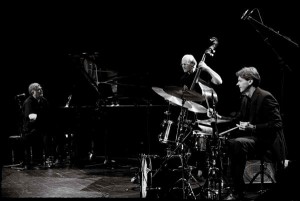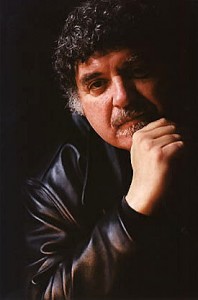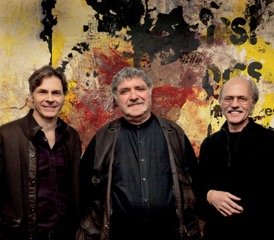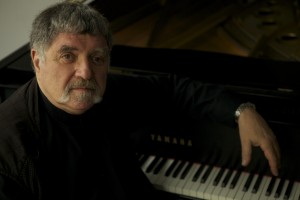Press Kit
- May 8th, 2012
- Posted in Hal Galper
- Write comment
Contact Info:
Hal Galper, Box 81, Cochecton, NY 12726
845: 932-8798
Galper’s 21st century series of trio albums for Origin Records incorporates his development of “Rubato” playing as a means of melding In his fifth decade as a major jazz artist, In his fifth decade as a major jazz artist, Hal Galper continues the innovation that has made him one of today’s most surprising and satisfying pianists. Galper’s 21st-century series of trio albums, with bassist Jeff Johnson and Drummer John Bishop on Origin Records, incorporates his development of “Rubato” playing as a means of melding melodic lyricism with the rhythmic excitement and “sound of surprise” of the bebop tradition, deepening the jazz experience for musicians and listeners alike. The trio’s latest Origin Records release, “O’s Time” is available at originarts.com
A student of the piano from the age of six, Galper entered the Berklee School of Music in Boston on scholarship in 1955 and studied technique with the famous Madam Chaloff. He quickly gravitated to the city’s jazz clubs, supplementing his formal Berklee training by studying the performances of such Boston stalwarts as Jaki Byard, Sam Rivers and Herb Pomeroy. It wasn’t long before Galper had soaked up enough practical jazz knowledge that he was employed as house pianist at The Stables, Lennie’s On The Turnpike, and Connelly’s, leading Boston jazz emporiums.
Beginning his international performing career in a three-year stint with trumpeter Chet Baker, he went on to be an integral member of the bands of Cannonball Adderley and Phil Woods. He also worked with Sam Rivers, Joe Henderson, Lee Konitz and John Scofield, among dozens of other major jazz figures. Supported by a grant from the National Endowment for the Arts, Galper formed one of his most critically acclaimed groups as a leader in the early 70’s with trumpeter Randy Brecker, his saxophonist brother Michael, bassist Wayne Dockery and drummer Billy Hart, the new Hal Galper Quintet debuted at Sweet Basil in New York’s Greenwich Village, eventually recording four albums including Reach Out, Speak With a Single Voice, Children of the Night, and Redux 78.
Galper’s discography includes 103 albums, with 32 of them under his name. He is a leader not only as a performer but also as an educator, with emphasis on theory, performance and the worldly side of music as a profession. He was a founding member of New York’s New School of Jazz and Contemporary Music and recently retired from his 14 year tenure at Purchase Conservatory. His best selling theory of Forward Motion was the first interactive E-book in which its more than 300 musical examples could be played in a computer browser. It offers insights into the workings of melodies, secrets of phrasing and ways of practicing to enhance jazz performance. Both the E-book and hard cover edition of Forward Motion, along with information on his other books and writings, are available at www.halgalper.com.
Long Biography
In his fifth decade as a major jazz artist, Hal Galper continues the innovation that has made him one of the most surprising and satisfying pianists alive. Galper is at the forefront of players reaching audiences through the time-tested magic of swing while integrating adventurous rhythmic and harmonic concepts. The exploration of rubato playing in his trio is uncovering possibilities that deepen the jazz experience for musicians and listeners alike. On the All About Jazz website, reviewer Dan McGlenaghan summarized the Galper effect:
“He has also found two like-minded musical brothers in bassist Jeff Johnson and drummer John Bishop, versatile and sophisticated players who can keep up with his “Rubato” concept, one of playing loose and free with tempo and harmony—even structure—twisting the familiar forms like a rubber band, then pulling them back and letting them fly free.”
Galper’s albums with Johnson and Bishop on the Origin label have attracted enthusiasm in Jazz Times, Downbeat, JazzIz and a variety of other publications. A typical reaction came in Downbeat’s review of Aerigin Revisited (2012): “…the high level of integration and communication the trio displays is rare and quite thrilling to experience…”
In his work as an educator, Galper’s teaching and writings provide emerging musicians and veteran players with theoretical knowledge to bolster their music making, and with business sense to help them toward professional success. A founding member of the New School of Jazz and Contemporary Music, where he still teaches, Galper is also on the faculty of Purchase Conservatory and frequently travels the college lecture-workshop circuit.
His theory of Forward Motion, first published as a series of articles in Downbeat, offers insights into the workings of melodies, secrets of phrasing and ways of practicing scales to enhance jazz performance. “As most problems with playing music are perceptual in nature,” Hal says, “to change the way you play you have to change the way you think.” He gives private instruction in person and in one-on-one lessons via broadband computer connections. His book Forward Motion has been a big seller since it first appeared. The E-book version was the first interactive E-book in which its more than 300 musical examples could be played in a computer browser. Both the E-book and the hard cover edition are available at www.halgalper.com. Galper’s The Touring Musician: A Small Business Approach to Booking Your Band on the Road is a practical guide to selecting and managing musicians, creating budgets, booking engagements and practical matters such as how to deal with the complexities and frustrations of air travel. Details about his all of his publications and educational videos and articles may be found on his website.
Born in Salem, Massachusetts on April 18, 1938, Galper was a classical piano student of from the age of six. In the 1950s he went to the Berklee School of Music in Boston on a scholarship. He absorbed formal jazz training at Berklee and supplemented his academic work by listening to trailblazing local heroes like pianist Jaki Byard, saxophonist and flutist Sam Rivers and drummer Alan Dawson. Soon, he was sitting in at The Stables, the club managed by Herb Pomeroy, one of his Berklee teachers. Before long, he became house pianist at The Stables and at two other Boston jazz landmarks, Connelly’s and Lenny’s On The Turnpike.
Among Galper’s first influences were Red Garland, Wynton Kelly, Jaki Byard, Bill Evans and Sonny Rollins. From his earliest days as a professional, he was noted for a stylistic range that encompassed not only the bebop that first inspired him but also the free approach pioneered in the late 1950s and early ‘60s by Ornette Coleman. Free jazz was important to the development of his concept, but bop was at the heart of his creative process. He told Cadence magazine, “ I would not be able to play the way I’m playing now if I hadn’t spent all those intervening years, since I heard that first album of Ornette’s, acquiring a firm jazz foundation via absorbing the vocabulary of bebop.”
On his journey through jazz, Hal has played with artists whose range of styles demanded flexibility. Among them have been Johnny Hodges, Roy Eldridge, James Moody, Art Blakey, Lee Konitz and Slide Hampton. He spent six years with his Boston mentor Sam Rivers and worked with Donald Byrd, Joe Henderson, John Scofield, the Bobby Hutcherson-Harold Land Quintet and the Brecker Brothers. Galper’s discography includes 99 albums, 32 of them under his leadership.
Reviewers in the mainstream and music press have singled out Galper for his daring ways. The New York Times found his music “adventurous, exploratory;” Billboard, “Four Star;” Record World, “Startling, very exciting indeed’; Downbeat, “energy-driven and versatile.”
That versatility is reflected in Galper’s days as a sideman. His first major engagement was three years as trumpeter Chet Baker’s pianist, followed by three with Cannonball Adderley and ten years touring and recording with the Phil Woods group. Baker said of the young Hal, “He’s a very good player…I like the way he plays and I like the way he writes. I asked him to sit in with me at the Jazz Workshop and hired him—just like that.” The work with Baker put Galper on the road, into important clubs in New York and other cities for the first time, and introduced him to recording. He is on Baker’s Baby Breeze (Verve) and The Most Important Jazz Album Of 1964-65 (Roulette). The 26-year-old pianist was launched.
“I learned a lot from Chet,” Hal says, “about dynamics, restraint, listening and how to play a ballad, but the parting of the ways came when I wanted to play more modern stuff. I couldn’t make it in New York alone and went back to New England in 1966.” Shortly, in an encounter that looked ahead to one of his most important associations, he met alto saxophonist Phil Woods.
“I was with the house band at Lenny’s,” he said. “Phil was the guest soloist and we played a week together. It was love at first beat.”
Back in New York in 1967, he joined Woods for one-nighters and played short engagements with a number of other top players including Byrd, Henderson, Stan Getz, Chuck Mangione and the Al Cohn-Zoot Sims quintet. Now established in the jazz community, leading the freelance jazz life in the jazz capitol of the world, he recorded three albums under his leadership for the Mainstream label, The Guerilla Band, Inner Journey and Wild Bird.
In 1973 Cannonball Adderley was looking for a keyboard player when George Duke was leaving to rejoin Frank Zappa. Galper auditioned by playing for a weekend with the Adderley quintet at Boston’s Jazz Workshop. That led to three years with the band and a practically nonstop round of touring. His primary role was to play electric piano, but he also composed for the quintet (“Second Son” and “My Lady Blue” are among his contributions) and appeared on three Adderley albums, Inside Straight; Love, Sex and The Zodiac; and Pyramid. “I’m still absorbing what I learned from Cannonball’s band,” Hal said. “I loved the high level of rapport and the energy, but I knew that after three years I didn’t need the road. The time had come to develop my own musical identity.” With regret and anticipation, he left Adderley in 1975.
Another factor in his departure was renewal of his dedication to the kind of piano he had spent most of his life playing. “After all, I was an acoustic pianist,” he said. Galper sealed his decision by wheeling his Fender Rhodes to the end of a dock on the Hudson River and tipping it into the water. He remembers watching bubbles rise to the surface as the instrument sank out of his life.
Supported by a grant from the National Endowment for the Arts, Galper mapped out a plan that included trumpeter Randy Brecker, his saxophonist brother Michael, bassist Wayne Dockery and drummer Billy Hart. The new Hal Galper Quintet debuted at Sweet Basil in New York’s Greenwich Village. They recorded albums for Steeplechase in 1976 (Reach Out) and Century in 1978 (Speak With a Single Voice). Bob Moses having replaced Hart on drums, they played at the 1978 Berlin Jazz Festival. Galper described the quintet as, “a very contemporary band. Everyone played with one hundred percent freedom. But after a while, the direction, the concept, became only a part of what I wanted to play.” Ready for more disciplined, more melodic music, he disbanded the quintet in 1978.
A sideman again, Galper toured with Lee Konitz, Nat Adderley, John Scofield and Slide Hampton. Then in September of 1979 he sat in for a week at the Village Vanguard with the Phil Woods Quartet. Woods hired him to be the award-winning band’s pianist-composer-arranger. “What a gig,” Galper said, “ten years recording and touring the world, playing acoustic bebop, a rare and fortunate experience.”
Galper’s discography includes 14 albums as a member of Woods’s band. During his last year with Woods, Galper’s success with Portrait, his trio album for Concord, encouraged him to again strike out on his own. Beginning in 1990, he toured six months a year with drummer Steve Ellington and and bassist Jeff Johnson. They recorded three more albums for Concord, trio CDs for ENJA and Double Time, collaborations with tenor saxophonist Jerry Bergonzi and trumpeter Tim Hagans, and the Galper-Johnson Maybeck Duets on the Philology label. Hal’s ESP-like compatibility with Johnson looked ahead to the transcendent achievements of his new trio.
“Everything is clear in hindsight,” Galper said, “so when I look back at my musical history I see that I’ve always displayed a penchant for ‘broken-time’ or rubato playing, where the beat is maintained but using subdivided or superimposed rhythms.” His mastery of that approach in the context of his trio with Johnson and Bishop produces some of the most intriguing and satisfying music of the 21st century.



FACULTY (Selected)
New School of Jazz and Contemporary Music,1986-Current
Purchase Conservatory, Retired 2014
William Paterson College, Fall Lecture Series, Current
Jamey Aebersold Jazz Camps 1980- 1995
Bud Shank Jazz Camp 1992- 1994
Stanford University Jazz Camp 1991
International Visiting Lecturer to over one hundred Colleges and Universities.
AWARDS
Artists Diploma: Berklee College of Music
Distinguished Alumnus Award: Berklee College of Music
IAJE Certificates of Appreciation: 1990, 1991, 1994, 1996
Harvard University Certificate of Appreciation: 1989
With the Phil Woods Group:
Since 1980, placed in the top three positions in the Down Beat Readers Poll for Best Acoustic Jazz Group, winning first place in 1985.
Since 1980, placed in the top three positions in the Down Beat Critics Poll for Best Acoustic Jazz Group, winning first place in 1988 and 1989.
In 1982, “Birds Of A Feather” was nominated for a Grammy.
In 1983, “Live At The Vanguard” won the Grammy for Best Instrumental Jazz Group (Acoustic) as well as the Grand Pix Du Disc of France.
In 1985, “Integrity: was voted Best International Jazz Record by the Italian Critics Poll.
In 1985, The group won the Golden Feather Award.
In 1987, The group won the National Association Of Jazz Educators Poll.
Hal Galper’s Trio:
“Invitation To A Concert” won #2 position in the Jazz Times Critics Poll of the top ten recordings of 1990.
“Redux ’78” won #5 position in the Jazz Times Critics Poll of1991.
“Best of ’91 Performance”, #4 position in top five, Earshot Magazine’s Critics Choice.
“Best of ’91 Performance #8 position in the top ten, The Boston Globe.
“1996 Award For Outstanding Service to Jazz Education” IAJE
Mr. Galper’s composition :”Gotham Seranade” won Billboard magazine’s Certificate Of Achievement in 1990 & 1991. He has over one-hundred original compositions recorded.
INSTITUTIONAL SUPPORT
National Endowment Of The Arts.
Lila Wallace-Readers Digest Foundation
Arts International Fund For U.S. Artists
The New England Foundation Of The Arts
National Jazz Service Organization
New York State Council Of The Arts
Delaware Arts Alliance
Arts Midwest
Mid-America Arts Alliance
New England Foudation Of The Arts
Southern Arts Federation
Western States Arts Federation
Meet The Composers Fund


